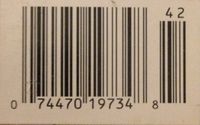UPC-A
Dan Tobias (Talk | contribs) (→Software) |
Dan Tobias (Talk | contribs) (→Utilities) |
||
| Line 29: | Line 29: | ||
* [http://www.upc-search.org/ Another UPC search site] | * [http://www.upc-search.org/ Another UPC search site] | ||
* [http://www.terryburton.co.uk/barcodewriter/generator/ Online barcode generator] (supports many different formats) | * [http://www.terryburton.co.uk/barcodewriter/generator/ Online barcode generator] (supports many different formats) | ||
| + | * [http://www.barcode-generator.org/ Another bar code generator] | ||
== References == | == References == | ||
Revision as of 04:38, 19 June 2013
UPC-A is the most common variety of UPC (Universal Product Code), at least in domestic USA usage. UPC is probably still the most commonly-encountered bar code in everyday life, though these days QR codes are catching up. Just about every product has one, and they are used at the checkout in most large stores to scan purchases into the cash register. UPCs were developed at IBM in the early 1970s and were in widespread use by the end of that decade. They are still in heavy use, though experts regard them as obsolete compared to newer bar code technologies which can encode larger amounts of information in a smaller size.
Another UPC format called UPC-E exists for use in more compact spaces.
EAN-13 is a slight variant that has 13 digits (instead of the 12 digits found on UPCs). The EAN-13 code is standard for all products sold outside the United States, and is used for some things such as books and medicines in the U.S. The 12-digit UPC is used on other US products. Modern point-of-sale systems used in all countries can handle both types of codes.
An optional additional bar code to the right of the UPC (or EAN) bar code encodes a supplemental 2 to 5 digits, used primarily on books and magazines. On magazines this encodes the issue number (the main bar code only encodes the periodical series) allowing issue-by-issue inventory tracking, while books use a supplemental code to indicate the suggested retail price.
Contents |
Software
- Review of barcode scanner apps
- iOS app to read UPC/EAN codes and find product info/prices
- Android app to read UPC and QR codes to look up product info/prices and other info coded or linked in bar codes
- Bar Code app (iOS)
Developer libraries and modules
- ZBar bar code reader library: cross-platform
- zxing (Zebra Crossing) (barcode library for Java, ported to some other systems)
- MediaWiki extension to generate UPC, EAN, and Code39 codes
Utilities
- Global UPC database
- Another UPC search site
- Online barcode generator (supports many different formats)
- Another bar code generator
